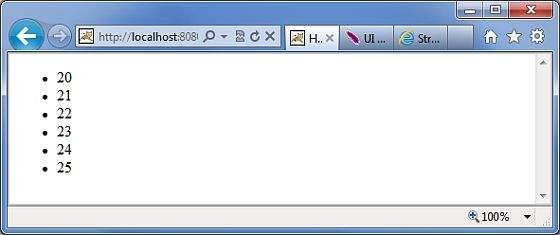Struts 2 - Param 标签
param 标签可用于参数化其他标签。include 标签和 bean 标签就是此类标签的示例。让我们以讨论 bean 标签时讨论过的相同示例为例。
创建 Action 类
package com.tutorialspoint.struts2;
public class HelloWorldAction {
private String name;
public String execute() throws Exception {
return "success";
}
public String getName() {
return name;
}
public void setName(String name) {
this.name = name;
}
}
创建视图
让我们拥有包含以下内容的 HelloWorld.jsp −
<%@ page contentType = "text/html; charset = UTF-8" %>
<%@ taglib prefix = "s" uri = "/struts-tags" %>
<html>
<head>
<title>Hello World</title>
</head>
<body>
<s:bean name = "org.apache.struts2.util.Counter" var = "counter">
<s:param name = "first" value = "20"/>
<s:param name = "last" value = "25" />
</s:bean>
<ul>
<s:iterator value = "#counter">
<li><s:property /></li>
</s:iterator>
</ul>
</body>
</html>
接下来让我们使用 employees.jsp 来制作以下内容 −
<%@ page contentType = "text/html; charset = UTF-8"%>
<%@ taglib prefix = "s" uri = "/struts-tags"%>
<html>
<head>
<title>Employees</title>
</head>
<body>
<p>An example of the include tag: </p>
<s:include value = "HelloWorld.jsp"/>
</body>
</html>
配置文件
您的 struts.xml 应如下所示 −
<?xml version = "1.0" Encoding = "UTF-8"?>
<!DOCTYPE struts PUBLIC
"-//Apache Software Foundation//DTD Struts Configuration 2.0//EN"
"http://struts.apache.org/dtds/struts-2.0.dtd">
<struts>
<constant name = "struts.devMode" value = "true" />
<package name = "helloworld" extends = "struts-default">
<action name = "hello"
class = "com.tutorialspoint.struts2.HelloWorldAction"
method = "execute">
<result name = "success">/HelloWorld.jsp</result>
</action>
<action name = "employee"
class = "com.tutorialspoint.struts2.Employee"
method = "execute">
<result name = "success">/employee.jsp</result>
</action>
</package>
</struts>
文件 web.xml 应类似于 −
<?xml version = "1.0" Encoding = "UTF-8"?>
<web-app xmlns:xsi = "http://www.w3.org/2001/XMLSchema-instance"
xmlns = "http://java.sun.com/xml/ns/javaee"
xmlns:web = "http://java.sun.com/xml/ns/javaee/web-app_2_5.xsd"
xsi:schemaLocation = "http://java.sun.com/xml/ns/javaee
http://java.sun.com/xml/ns/javaee/web-app_3_0.xsd"
id = "WebApp_ID" version = "3.0">
<display-name>Struts 2</display-name>
<welcome-file-list>
<welcome-file>index.jsp</welcome-file>
</welcome-file-list>
<filter>
<filter-name>struts2</filter-name>
<filter-class>
org.apache.struts2.dispatcher.FilterDispatcher
</filter-class>
</filter>
<filter-mapping>
<filter-name>struts2</filter-name>
<url-pattern>/*</url-pattern>
</filter-mapping>
</web-app>
右键单击项目名称,然后单击 Export > WAR File 以创建 War 文件。然后将此 WAR 部署到 Tomcat 的 webapps 目录中。最后,启动 Tomcat 服务器并尝试访问 URL http://localhost:8080/HelloWorldStruts2/hello.action。这将产生以下屏幕 −

在此示例中,我们正在实例化 org.apache.struts2.util.Counter bean 的新实例。然后我们将第一个属性设置为 20,将最后一个属性设置为 25。这意味着计数器将具有值 20、21、22、23、24 和 25。我们给 bean 起名为"counter"。 struts bean 标签实例化 bean 并将其放入值堆栈中。现在我们可以使用迭代器遍历 Counter bean 并打印出计数器的值。
 struts_data_tags.html
struts_data_tags.html

